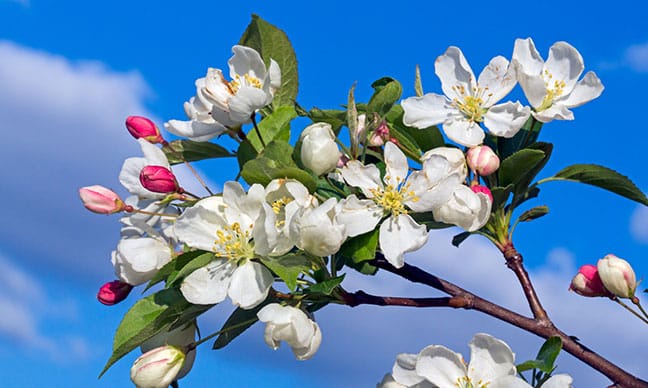Flowering trees liven up our homes in a big way. They hide unattractive views, revamp our yards, and some even have the added advantage of providing us with shade and edible fruits later on.
But planting trees is an investment both in time and money. You, therefore, need to make your selection wisely so you can enjoy beautiful landscapes for many years to come.
If you are looking to plant flowering trees in Texas, your best option would be those that do well in the area’s climatic and soil conditions and can withstand the scorching summer temperatures. Here are ten to get you started!
Related Posts: Best Time To Plant Trees In Texas & Texas Soil
10 Flowering Trees In Texas That Will Add Pizzazz To Your Yard
If you are looking for flowering trees to adorn your Texas home, you may want to know, “What is the prettiest flowering tree?” Well, here is a list of the prettiest Texas flowering trees to perfect your patio ambience and create a picturesque backdrop for your backyard bbq.
1. Purple Leaf Plum
Nothing adds glamor to Texas homes like the purple leaf plum trees in their full bloom. Their beautiful white and pink flowers in the spring are such a sight to behold. And even when not in bloom, the tree’s purple, reddish leaves will still give your eyes something to feast on.
A purple leaf plum tree needs full or partial shade to grow and can grow up to 20 feet tall and 15 feet wide. Water it moderately and more in the dry season.
2. Crape Myrtle
The crape myrtle comes in different varieties, all with different flower colors, trunk colors, and height. The bloom color usually ranges from pink to lavender. Some crape myrtle varieties are considered a shrub while others are actual trees. Because of these many varieties, crape myrtle are great to plant in multiples.
Also, since they are fast growing, enjoy full sun, and don’t need much maintenance, gardeners love them, hence, they are some of the most popular flowering trees in Texas. Like the purple leaf plum, this tree requires moderate water too.
Related Post: Crape Myrtles Texas
3. Vitex
Also known as the Texas lilac, the vitex is another showstopper that has been used to spruce up Texas landscapes for years. The tree appears more like a shrub, usually growing to a height of 15 feet and spreading 10 feet wide.
Vitex is drought tolerant and does great in direct sun. It blooms between May and September, showcasing spiky lavender flowers that attract bees and butterflies. This tree is deciduous and will lose its leaves during winter.
4. Texas Redbud
Another Texas flowering tree that loves sunlight is the redbud. This little beauty is one of the best flowering trees in Austin. It has heart-shaped leaves and produces gorgeous pink-purple blossoms in the spring. The leaves usually emerge reddish in color and turn dark green toward the end of spring, and then yellow in the autumn, keeping your garden livened up all year round.
Under the right conditions, Texas redbuds can grow up to 20 feet high and their branches can spread up to 15 feet wide. They are drought resistant and flourish best in full sunlight and light shade.
5. Texas Mountain Laurel
The beautiful and elegant Texas mountain laurel is a favorite of many homeowners for a good reason; it is drought tolerant, easy to maintain, and doesn’t seem to be bothered by most of the tree diseases experienced in Texas. Provided with the right conditions for growth – well-drained soils, full or partial sunlight, and enough space – a mountain laurel can grow up to 20 feet high.
This small tree is evergreen but steals the show in March when it blooms with gorgeous purple flowers that put out a delicious scent. Kids love it, but be careful with the silvery pods it produces toward the end of summer. The pods contain a red bean that has been found to be highly poisonous.
6. Yaupon Holly
The yaupon holly can be pruned into a hedge or hedge screen or be left to grow into a shade tree, as the tree can reach a height of 30 to 35 feet. This makes it an excellent choice for homes and commercial landscapes.
It is evergreen and produces small brilliant white flowers in the spring. The female plants yield red berries that grace your patio till autumn. The dense bloom and berries attract insects and birds all year round. The leaves can be processed and used for tea!
Related Posts: Texas Tree Bugs & Evergreen Trees Texas
7. Eve’s Necklace
A cousin of Texas mountain laurel, the Eve’s necklace, makes it to our list as another popular Texas flowering tree. It is considered a shrub often growing to a maximum height of 10 to 15 feet. The tree is easy to maintain and grows best in direct sun or moderate shade.
Eve’s necklace maintains healthy green leaves throughout the year, and come spring, pink flowers hang in beautiful clusters, attracting bees and butterflies. Unfortunately, like mountain laurel, this tree produces pods that have been reported to contain poisonous seeds. The pods appear like a string of beads, hence the name eve’s necklace.
8. Desert Willow
Meet the dessert willow, another low maintenance, drought tolerant tree that thrives in full sun. You can grow it as a small tree or trim it into a shrub. The tree has beautiful willow-like leaves that appear light green in color and produces a burst of scented pink flowers in mid-summer. The flowers form in clusters around the tips of the limbs and have been found to be a great attraction for bees and hummingbirds.
A desert willow prefers well drained soils, can withstand the scorching heat of Texas summers, and even in dry conditions, the tree doesn’t need much watering. It is, by far, one of the easiest trees to care for, meaning you won’t have to spend money on tree service Texas companies for regular maintenance.
9. Dogwood
Dogwoods enthusiastically announce spring with elegant white blossoms but may also exhibit pink or other colors depending on the variety. They are the some of the most popular flowering trees in Dallas Fort-Worth area and East Texas and will keep your home vibrant all year round.
In fall, the tree produces crimson foliage that give way to small, red fruits in winter. Plant dogwoods in well-drained soil where there is partial shade to thrive.
Related Post: Fall In Texas
10. Japanese Maple
A Japanese maple is an elegant addition to any landscape. It comes in many varieties, all with different foliage colors. The tree initially has green leaves that quickly transform into shades of dark red and yellow at maturity.
This medium-sized beauty loves shaded areas and will do best under larger trees. The only downside of Japanese maples is that unlike all the trees we have discussed above, these ones don’t like the sun. However, if you have plenty of shade in your property, they can be a great option.
What Are The Most Common Trees In Texas?
The most common trees in Texas are the:
- Cathedral oak
- Camphor tree
- Red maple
- Bonita ash
- Italian cypress
- Cottonwood tree
- Sycamore
- Tipu tree
- Live oak
- Cedar elm
What Is The Best Tree To Plant In Texas?
The best tree to plant in Texas is the one that is heat tolerant, drought resistant, and can withstand the severe weather experienced throughout the year. Some of the trees that have been found to meet these conditions include the:
- Bur oak
- Live oak
- Magnolia
- Bald cypress
- Cedar elm
Related Post: Texas Shade Trees
The Local Tree Experts Overview
We all want our yards to look beautiful, and there is no better way to give your space a facelift than planting flowering trees. There are many flowering trees in Texas that can be used for residential and commercial landscaping. We have listed the easiest to obtain, grow, and maintain to help you make the perfect selection. Pick a few for your garden and achieve that radiance you have always desired.




